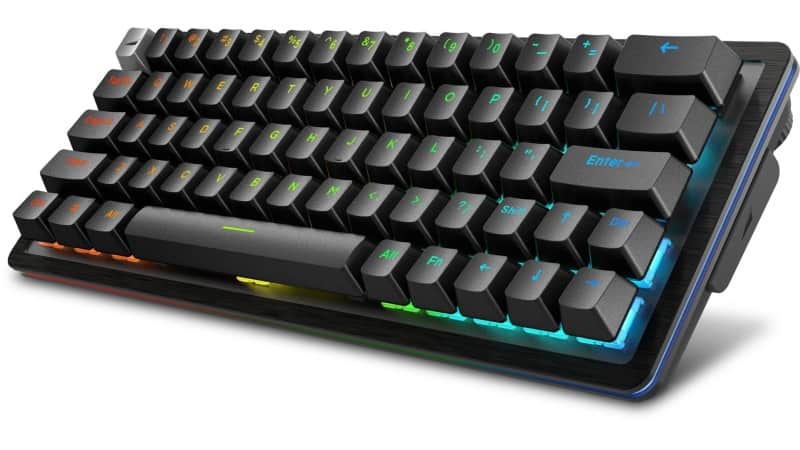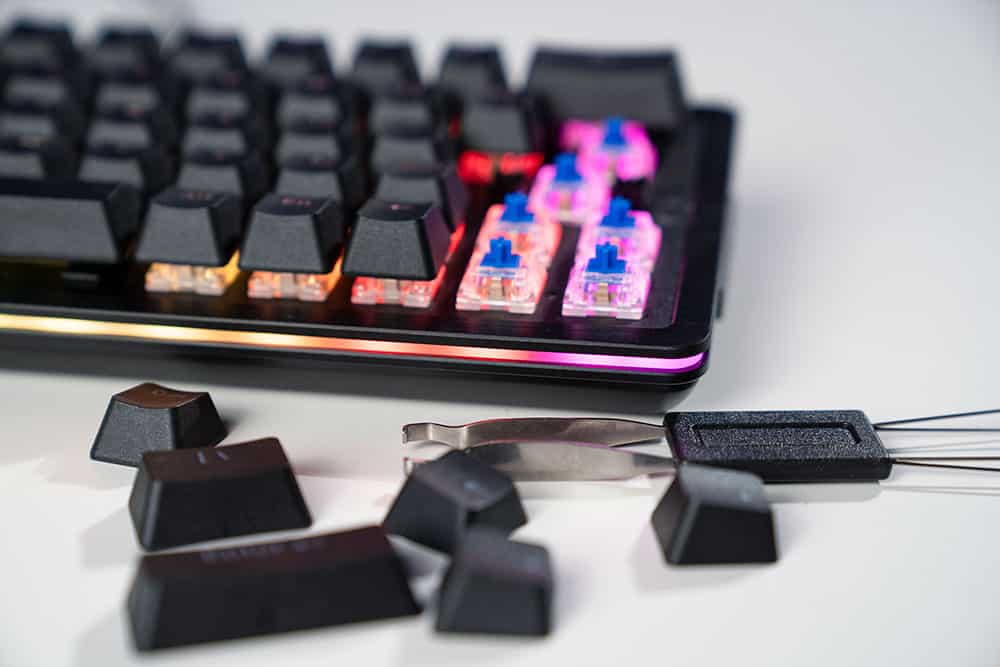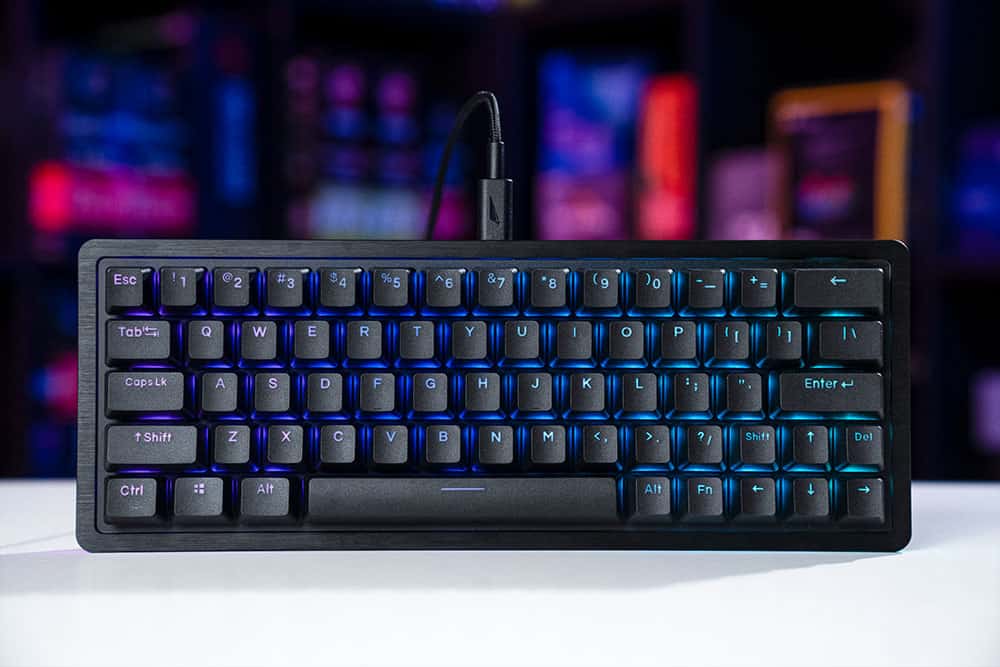
[ad_1]
Last Updated:
Mountain has only been in the peripheral game for four years. Despite them being newcomers to the scene when compared to long-time players like Logitech, Razer, and Corsair, they’ve managed to make a significant name for themselves, for their product quality and innovations in the realm of modularity. Modularity is even included as one of the four pillars that make up their ‘Mountain design mission’.
They’ve now hit the market with the Mountain Everest 60 keyboard, which takes their modularity pillar, and applies it to the compact 60% form factor. This makes sense as small gaming keyboards are growing in popularity as people abandon the Numpad in droves, small boards are particularly popular among keyboard enthusiasts, which is exactly the area that Mountain is trying to make more accessible with the Everest 60.


Mountain Everest 60 gaming keyboard
Switch type
Pre-lubed Mountain Tactile 55
Hotswappable?
Yes, with 3 or 5-pin Cherry-style switches
Pros
-
Superb gaming and typing experience -
Satisfying sound profile -
Foam and silicon padding make for a tactile experience -
Vivid lighting -
Industrial and minimalist design
Cons
-
Buggy software -
Modular connection is loose
Pre-lubed Mountain Tactile 55
Yes, with 3 or 5-pin Cherry-style switches
Cherry MX, pre-lubed, plate-mounted
What’s in the box & setup
- Mountain Everest 60 gaming keyboard
- USB Type-A to Type-C cable
- Quick start guide
- Stickers!
- keycap/key switch puller
- Mountain logo keycap
- Magnetic riser feet
The unboxing of the Everest 60 is an enjoyable experience for a few specific reasons that we don’t see too often around here. First up is the very sturdy box, featuring a two-tone blue and grey design, with ‘REACH YOUR SUMMIT‘ embossed in a glossy font. The artistic box then opens up via satisfying magnetic clasps to reveal the keyboard itself.
Previous
Next
You are immediately presented with the Everest 60 coddled within a cardboard insert, lifting the insert and the board free of the box reveals the accessories hiding beneath. These are all seated within high-density packing foam in their own little cut-outs. Curiously, the keyboard itself isn’t, so despite being well protected from underneath, there is no protection on the top. The box is very sturdy so don’t worry too much, but we would have appreciated a small layer of foam to protect the top of the keyboard just in case.
Setting up the keyboard is as simple as plugging the USB Type-C cable into one of three ports on the board (more on that later) and inserting the other end into your PC. You are then presented with a blue lighting animation that either makes the board look like it’s charging or like it’s about to explode, depending on who you ask.
Design
Industrial and minimalist are two words that are equally accurate for describing the design of the Everest 60. The squared-off 60% form factor is surrounded by a brushed aluminum bezel that some of us here at WePC find to be a little too wide, however, there is a reason for this width as it contains a light diffusion strip. This brings us smoothly onto the RGB lighting.
It’s not the brightest we’ve seen, however, the implementation of the diffuser creates a nice aesthetic halo of color around the keyboard. It does allow some light to splay out onto the desk surface, but this is only visible in very low lighting conditions. The Everest 60 is capable of creating quite the light show, but we’ll get to that in the ‘software section’ of this review.
Taking a look at the PBT double-shot keycaps, we see a unique font used for the legends. The symbols are slightly more rounded than what we’ve seen from other companies, but not so rounded as to resemble a handwritten font like comic sans, thank god. Cutting it close there, Mountain. Branding is very sparse on the Everest 60, out of the box it comes with a replacement escape keycap bearing the Mountain logo, but a normal one is included for those of you who like to roll brand-neutral. With the cap swapped out, there is zero branding visible on the board from the front. There are a lot of logos and branding on the underside of the board, but given its location, we’ll allow it.
Build quality
Despite the relatively pedestrian price point of the Everest 60, its construction is incredibly sturdy, exhibiting only a little flex when aggressively twisted. This rigidity is due to the thick aluminum top plate, an example of form and function working together which is always nice to see. Additionally, the magnetic riser feet snap together very satisfyingly and will last far longer than the traditional flip-out feet we are used to.

As alluded to earlier, the PBT double-shot keycaps feel very solid and have a pleasing texture to the touch which is barely visible, but just physically prominent to make the keycaps feel great. The included USB Type-A to USB Type-C cable is nicely braided and remarkably flexible for a keyboard cable, the connector housings on each side are embossed with an almost invisible Mountain logo, which makes for subtle branding, subtlety being a rarity in gaming peripherals these days.
The included key switch/keycap puller is awful, however, with some of the stiffest wires we’ve seen that makes it somewhat difficult to use. Make sure to have an alternative one handy if you’re planning on swapping the caps or switches out as it will save a little bit of time and a lot of hassle as the ends of the keycap puller have to be manually pulled apart to get over the cap which is annoying.
Gaming performance
The Everest 60 performs very well, with a quiet audio profile that helps focus on the game in question and extremely grippy rubberized feet that keep the board planted. This prevents movement around the desk even when faced with the most violent of keystrokes when aggressively spamming through menus after losing at Apex Legends, again. We were provided with the Mountain Tactile 55 switches, which are tactile key switches akin to the parochial Cherry MX Red.

We’d recommend picking up this board with either the Mountain Linear 45 or the Linear 45 Speed switches if you need peak performance. Happily, the Everest 60 is hot-swappable and compatible with 3 or 5-pin Cherry MX style switches, so if Mountain’s range of switches doesn’t float your boat, any other MX style key switch will fit on this board too. The Tactile 55’s performed well for gaming, but we think they are better suited to non-gaming uses. Speaking of which, let’s talk about typing.
Typing experience
At the risk of sound hyperbolic, the Everest 60 with Moutain Tactile 55s is potentially the best keyboard for typing we’ve tested at WePC. The slightly higher actuation force of 55g combined with the pleasant tactile bump at the actuation point makes for a very pleasant typing experience. Additionally, the two layers of soundproofing foam and the silicon pad within the keyboard make bottoming out far less jarring than most other keyboards.
Over the course of two weeks, around 20,000 words were typed on this board and it never skipped a beat or caused any fatigue. The sound is of particular note too, even though the switches aren’t clicky, the keystrokes produce such a satisfying thud that even my colleague had to come over and compliment it.
Key switches
Getting this far in the review, you might have been confused at the mention of mountain switches. This is because until now, Mountain shipped all their keyboards with Cherry MX switches. The Everest 60 is the first board to showcase the all-new mountain switches.
As mentioned earlier, the review sample we were provided with was outfitted with the Mountain Tactile 55 key switches, these are analogous to Cherry MX Browns, but feel way better to use. Even though they feature almost identical specs, with 2.00mm pre-travel, 4.0mm total travel, and a marginally lighter actuation force of 55 grams vs the MX Brown’s 56-gram actuation force. So if they are nigh-on identical in terms of specs, why do they feel so different?

You may remember from the intro that we stated that Mountain was trying to make the DIY keyboard experience more accessible, well, this is how they are doing it. All Mountain switches are factory-lubed and the genuine Cherry Stabilizers are clipped and lubed from the factory too. Pre-lubed switches and clipped stabilizers are almost never available from big manufacturers, and these modifications are usually only made by mechanical keyboard enthusiasts.
Doing these mods at home is a messy process requiring a few tools and an additional purchase of lubricant, in addition to the keyboard itself and the switches. Mountain has provided an alternative to this by selling a DIY-level keyboard out of the box. There will always be avid DIY-ers, which we love, but it’s nice to see a similar experience without the hassle. Additionally, given the hot-swappability of the Everest 60, you can use this as a jumping-off point for getting into the DIY mechanical keyboard scene.
Modularity
We mentioned how modularity is one of the core pillars of Mountain’s design mission earlier, so let’s get into that a little more. Since the launch of the game-changing original Everest keyboard and its modular media bar and Numpad, they’ve doubled down on the concept of modularity. The Everest 60 is, we think, the ideal candidate for modular expansion for a few very specific reasons.

First up is the form factor. Whichever way you cut it, a 60% form factor keyboard has limitations, while it may look great and save space, the lack of a Numpad and F keys makes it less-than-ideal for some people. Given the explosive growth in numbers of people working from home, the Everest 60 has come at a most opportune moment, the modular Numpad provides functionality and efficiency for work-related tasks like spreadsheets, then, when 5 pm rolls around, simply yank it off and return the board to its 60% size and get to gaming.
We mentioned multiple USB Type-C ports during the setup section and now we can explain the reason for having so many. In addition to the Modular Numpad, Everest also has an optional Media bar that clips to the top of the keyboard via your choice of the three USB C ports. We didn’t manage to get our hands on one of these, but they have a lot of functionality and are worth considering if the 60% form factor has got you missing your media keys.
Everest 60 modular numpad
Of course, this isn’t the first-ever detachable Numpad, Mountain has done it before, and so did ASUS with the ROG Claymore. However, this is the best implementation of a modular Numpad we’ve seen for a few reasons, specifically the connection method, and the overall magnetic ecosystem that Mountain has created. We have to note here that the Numpad is not included, it can be bought separately or in a bundle with the Everest 60.
Previous
Next
The Numpad can be attached to either side of the Everest 60, this is accomplished by a double-sided connector hidden in the base, simply slide the tab on the underside to reveal the male USB Type-C connector on your chosen side. The USB C connector is flanked by a small magnetic pin on each side, these correspond with the awaiting magnets and female USB C connection on the board itself. Line it all up and click it into place, it’s not a flawless system, however, with a few issues inherent in the design.
The main issue is a lack of rigidity when the Numpad is connected. picking up the board without supporting the Numpad causes it to sag down, putting strain on the USB C connection. Additionally, even when placed on a desk, slightly repositioning the keyboard reveals a lot of play in the connection, which is annoying for gaming because the keyboard often gets slightly moved around the desk. Perhaps a mixture of stronger magnets and making the Numpad lighter could resolve this issue in the next product revision.
Software
Unfortunately, Mountain loses a few points in this department as the Base Camp software, while aesthetically pleasing, is lacking some functions which are standard in the competition, and is a little buggy to boot. Of course, we have to bear in mind that the version of Base Camp we were using was a pre-release build, so some bugs are expected, but we are still going to mention them so as to be as thorough as possible.
First of which is the keyboard not being detected by the PC if it’s plugged in before start-up, necessitating the unplugging and replugging of the board. Not exactly inconvenient given the removable USB Type-C cable, but still puzzling nonetheless. Additionally, the custom lighting options only allow you to use static colors to make your own designs, you cant mix and match the pre-configured lighting effects this is disappointing given the potential of lighting provided by the diffuser around the rim of the Everest 60. Overall the software leaves a lot to be desired, but a few choice updates could bring it up to speed.
Final verdict
The Mountain Everest 60 is an excellent keyboard for gaming and general use. Through a deft combination of foam padding, silicon inserts, and pre-lubed switches, Mountain has created a keyboard with a DIY feel straight out of the box. Additionally, they have kept the design very open, so you can hot-swap switches, caps, stabilizers, etc to your heart’s content, this makes the Everest 60 an ideal jumping-off point for those of you eager to get into the intimidating world of custom mechanical keyboards.
Previous
Next
The downsides are few and far between which is a rarity in the gaming keyboard market, but there will always be some. In the case of the Everest 60, these take the form of the buggy and feature-light software and the Numpad connection. Thos the modular connectivity is novel, it leaves something to be desired when it comes to rigidity and there’s too much flex for our liking.
We’ve reviewed a lot of gaming keyboards here at WePC and this is one of the best, so we have no choice but to highly recommend it as it’s an excellent example of clever design, attractive aesthetics, and attention to detail. All three of which aren’t often found in the gaming peripheral market.
[ad_2]












